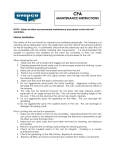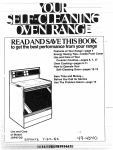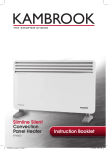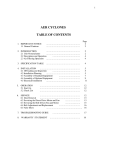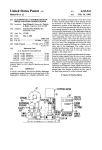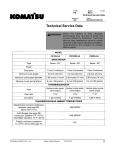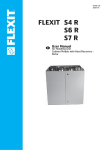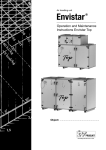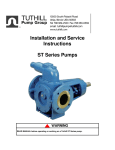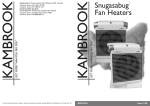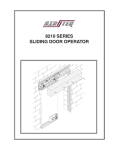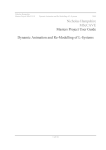Download LOUIS ALLIS PACEMAKER MOTOR
Transcript
SERVICE MANUAL SECTION 16, Page 511 April, 1984 r Supersedes April, 1978 LOUIS ALLIS PACEMAKER MOTOR C317 GENERAL PURPOSE SQUIRREL CAGE MOTORS DRIP-PROOF HORIZONTAL FRAMES 180 THROUGH 440 Drip-Proof Pacemaker 180-250 Frame RECEIPT OF SHIPMENT When your equipment arrives, it should be checked immediately to see that all components have been received and that there is no evidence of damage in shipment . In the event the complete assembly has not been received, or arrives in a damaged condition you should without delay notify the carrier who handled the shipment and the nearest Louis Allis Sales Office . Drip-Proof Pacemaker 280-440 Frame When mounting, we recommend the use of slotted shims as it may be necessary to remove or add shims when aligning shafts . The use of proper shims inserted under each mounting foot will prevent distortion of the housing when the mounting bolts are secured . The following procedure is recommended when mounting the motor . 1 . Add shims under the lowest mounting foot and tighten mounting foot bolt . 2 . Insert feeler gauges under the other mounting feet to determine amount of shims required . STORAGE If the equipment is not put into immediate use it should be stored in a clean, dry location . For long periods of storage, especially where moisture or dust is prevalent, the equipment should be covered to protect it from corrosion . 3 . Insert required shims under each mounting foot and tighten mounting bolts . 4 . Use a small number of thick shims rather than a large number of thin shims . 5 . Measure the alignment . LOCATION In selecting a location for the unit, first consideration should be given to ventilation . It should be far enough from walls or other objects to permit a free passage of air . The motor should never be placed in a room with a hazardous process, or where flammable gases or combustible material may be present unless it is specifically designed for this type of service . INSTALLING COUPLING AND SHEAVES The .flexible coupling or sheave should be heated in oil before installation and slid into position on the shaft or installed with a pushing device . MOUNTING The motor should be securely mounted on a bed plate, base or platform that is rigid enough to prevent any vibration of the unit and also prevent transfer of vibration to the unit . The base must not impose bending or twisting strains on the housing . COPYRIGHT © 1984 LOUIS ALLIS PRICES AND OTHER DATA SUBJECT TO CHANGE WITHOUT NOTICE . http://legacy.library.ucsf.edu/tid/wtk23e00/pdf WARNING : DO NOT DRIVE OR FORCE COUPLINGS OR SHEAVES ONTO THE SHAFT . DAMAGE TO BEARINGS MAY RESULT . REFER TO THE COUPLING MANUFACTURER'S INSTRUCTIONS FOR THE PROPER INSTALLATION PROCEDURE'. LOUIS ALLIS Mibrdaukee W Scons n 53201 2030050365 SERVICE MANUAL SE~CTION 16, Page 542 April, 1984 r Supersedes Febcua<y, 198I ALIGNMENT (Direct Connected) STRAIGHT EDGE ANGULAR MISALIGNMENT and RUN-OUT between direct connected shafts will cause increased bearing loads and vibration even when the connection is made by means of a flexible coupling . LOAD To check for ANGULAR MISALIGNMENT, clamp the dial indicator to one coupling hub and place the finger, or button of the indicator against the finished face of the other hub as shown in the diagram below . MOTOR Aligning Belted Drive TEMPERATURE The ambient temperature of the air surrounding the motor should not exceed 40°C or 104°F unless the motor has been especially designed for high ambient temperature applications . The free flow of air around the motor should not be obstructed . COUPLING HUBS ;. Checking for Angular Nfrsalignment Rotate both shafts simultaneously, keeping the indicator button at the reference mark on the coupling hub, and note the reading on the indicator dial at each one-quarter revolution . ANGULAR MISALIGNMENT OF THE SHAFTS MUST NOT EXCEED A TOTAL INDICATOR READING OF .002 INCH FOR EACH INCH OF DIAMETER OF THE COUPLING HUB . After the shafts have been checked for angular misalignment and are parallel within the limits specified in the preceding paragraph, check the shaft for RUN-OUT to assure concentricity of the shaft . Clamp the indicator to one coupling hub and place the indicator button on the machined diameter of the other hub as shown in the diagram below . NEVER ATTEMPT TO MEASURE THE TEMPERATURE RISE OF A MOTOR BY HAND . Temperature rise MUST be measured by thermometer, resistance, or by imbedded detector or thermocouple . WIRING Before starting the motor, check the nameplate to insure that the correct power supply (voltage frequency, and phase) is being used and that the motor is connected according to the connection diagram on the nameplate . Be sure that the motor is connected for the correct rotation . Before connecting the driven machine, energize the motor and check the rotation . THERMOSTATS Standard Louis Allis Pacemaker motors are equipped with normally closed winding thermostats as required to comply with Underwriters Laboratories regulations on motor surface temperature . Thermostats are located in the winding, and the leads are marked X1, X2 . The leads are to be connected in the control circuit so that when the thermoguard is activated the power source to the motor will be disconnected . Class I Group D units do not require thermostats . OPERATION COUPLING HUBS Checking RUN-OUT of Directly Connected Shafts Rotate both shafts simultaneously, keeping the indicator button at the reference mark on the hub and note the reading on the indicator dial at each one-quarter revolution . TOTAL RUN-OUT BETWEEN HUBS SHOULD NOT EXCEED .002 INCH . ALIGNMENT (Belted) Aligning a belted drive is much simpler than aligning a direct coupling drive . To check alignment, place a straight edge across the faces of the driver and driven sheaves . If properly aligned, the straight edge will contact both sheave faces squarely . The figure below shows the correct alignment of sheaves . LOUIS ALLIS M,WaUkeE WI$CQ(15 :r1 7Z?(1! http://legacy.library.ucsf.edu/tid/wtk23e00/pdf Alternating current motors shall operate successfully at rated load and frequency with voltages not more than 10% above or below nameplate ratings . Motors shall operate successfully at rated load and voltage with frequency variations not more than 5% above or below the rated frequency . Motors shall also operate successfully at rated loads with combined variations in voltage and frequency not more than 10r/o above or below the rated voltage and frequency provided the frequency variation does not exceeed 5% . Motors operated with the above listed conditions are not necessarily in accordance with the guarantees for standard conditions . REGREASING Lubrication for Motor With Grease Fittings Under normal operating conditions, it is only necessary to regrease a ball bearing motor every two to six years, depending upon the motor speed and operating conditions . A sound greasing procedure should be followed when regreasing a motor for it has been determined that THE GREATEST CAUSE OF BEARING FAILURE IS OVER GREASING RATHER THAN UNDER GREASING . PRICES AND OTHER DATA SUBJECT TO CHANGE WITHOUT NOTICE . 2030050366 SERVICE MANUAL SECTION 16, Page 543 Aprit, 1984 Supersedes February, 1981 Nhen regreasing the following steps shotdd be followed : Lubrication for Motor Without Grease Fittings 1 . Clean the exterior of the motor . Bearings are factory lubricated for normal life . In the case of double shielded bearing the grease provided is that which is in the bearing . 2 . Remove both the grease plug and relief plug (if supplied) . R'hen regreasing the following steps should be taken . 3 . If grease has hardened, run a rod or wire a short distance into chamber to break grease . In severe conditions, run motor until bearing chamber becomes heated . l . Remove fan guard 2 . Remove fan . 3 . Remove front and back cartridge bolts . 4 . Regrease motor with low pressure grease gun . 4 . Remove bearing brackets . 5 . For optimum operation, the bearing chamber should be threequarters full of grease . 6 . Operate motor for minimum of one hour . 7 . Replace grease plugs . 5 . If original bearing is to be relubricated, remove shield opposite rotor . Do not replace . Flush old grease from bearing with suitable solvent . Lubricate bearing and add additional grease to bearing chamber . Chamber should be three-quarters full of grease . 5a . An alternate method is to replace old bearing with new double shield prelubricated bearing . NOTE : If the bearings are rough, the motor should be disassembled and the bearings replaced . Repack the bearings and bearing chamber with enough grease so that the bearing chamber of the assembled motor will be approximately three-quarters full . 6 . Bearing to be lubricated with recommended grease . 7 . Reassemble motor . RECOMMENDED BALL BEARING GREASES FOR NORMAL CONDITIONS* It is recommended that these greases or their equivalents be used in Louis Allis motors . Company NORMAL Ambient Temperature -20°F to 105°F HIGH Ambient Temperature 0 to 150°F Chevron Oil Co . Shell Oil Co . SRI No . 2 Dolium R SRI No . 2 Dolium R Shell Oil Co . Texaco Darina No . 2 Premium RB Darina No . 2 Premium RB Texaco Mobil AFB No . 2 Mobilux No . 2 AFB No . 2 Mobiltemp SHC 32 Mobil Mobilgrease 28 Mobilgrease 28 Gulf Oil Gulf Crown No . 2 Gulf Crown No . 2 Exxon Unirex N2 Unirex N2 *NORMAL conditions are considered to include most ambient atmospheres and operation requirements . SEVERE conditions include the following : RECOMMENDED REGREASING SCHEDULE FOR BALL BEARINGS" Extreme dust, dirt or other atmospheric contaminants . Direct exposure to moisture beyond normal atmospheric humidity . Shock, vibration or other loading beyond rated . Extremes of operation cycle such as long shutdown, frequent starting or reversing . Approximate Hours of Operation Motor Speed 1200 & Below Normal Conditions Severe Conditions 6000 - 8000 3000 - 4000 1800 3000-4000 1400-2000 3600 1500 - 2000 750 -1000 For lubrication recommendations covering above SEVERE conditions refer to special lube instructions furhished, or consult nearest Louis Allis Sales Office . For roller bearings refer to special lube instructions or Louis Allis Sales Office . PRICES AND OTHER DATA SUBJECT TO CHANGE WITHOUT NOTICE . http://legacy.library.ucsf.edu/tid/wtk23e00/pdf **For roller bearings 1800 RPM and below and in the absence of other instructions, it is recommended that the above hours be reduced to 1/3 listed values . LOUIS ALLIS MiIwaukeE WtSCOns,n 5320, 2030050367 SERVICE MANUAL aSECTION 16, Page 514 Aprtl, 1984 Supersedes Ap~N, 1978 LOUIS ALLIS PACEMAKER MOTOR , Drip-Proof Pacemaker 140-250 Frame 4 . Rotor 7. 8. 9. 10 . 5 . Front Bearing 11 . Back Bearing Bracket Bolt 17 . Conduit Box Gasket 6 . End Cover 12 . Back Air Deflector 18 . Housing 1 . Front Bearing Bracket 2 . Front Air Deflector 3 . Fan Stator Screens Conduit Box Lifting Lug (Not Included 140-250) 13 . Back Bearing 14 . Back Bearing Lock Nut with Washer 15 . Shaft 16 . Back Bearing Bracket NOTE : Special motors such as flange mounted motors and/or motors with special shafts may not follow the above parts list exactly . However, construction details will be similar to the above and parts lists are available upon request . When ordering repair parts, always give the serial number of the motor being serviced, the part name and number and furnish complete nameplate data . Drip-Proof Pacemaker 280-440 Frame LOUIS ALLIS Milwaukee W SConsin 53201 http://legacy.library.ucsf.edu/tid/wtk23e00/pdf PRICES AND OTHER DATA SUBJECT TO CHANGE WITHOUT NOTICE . 2030050368




